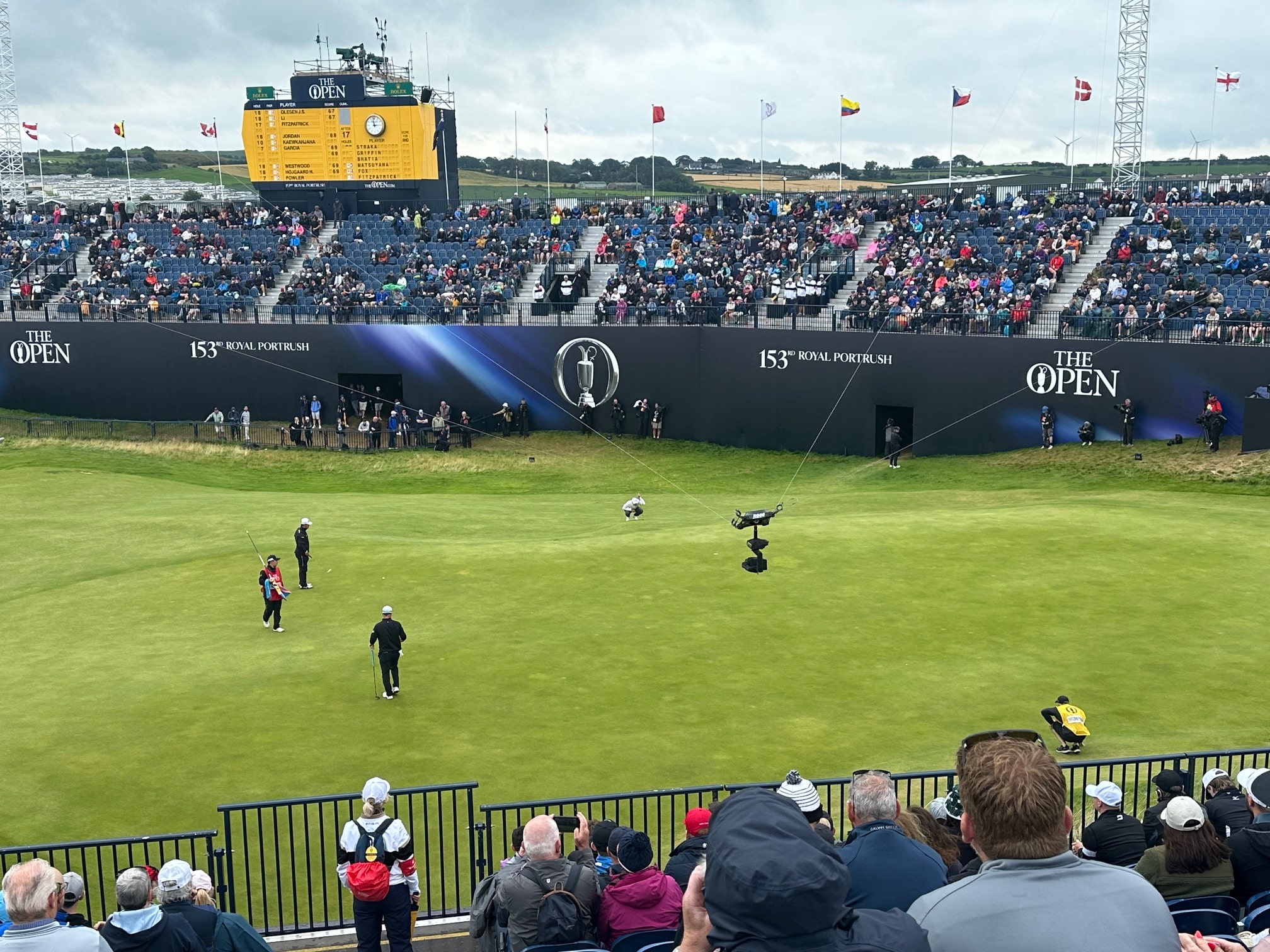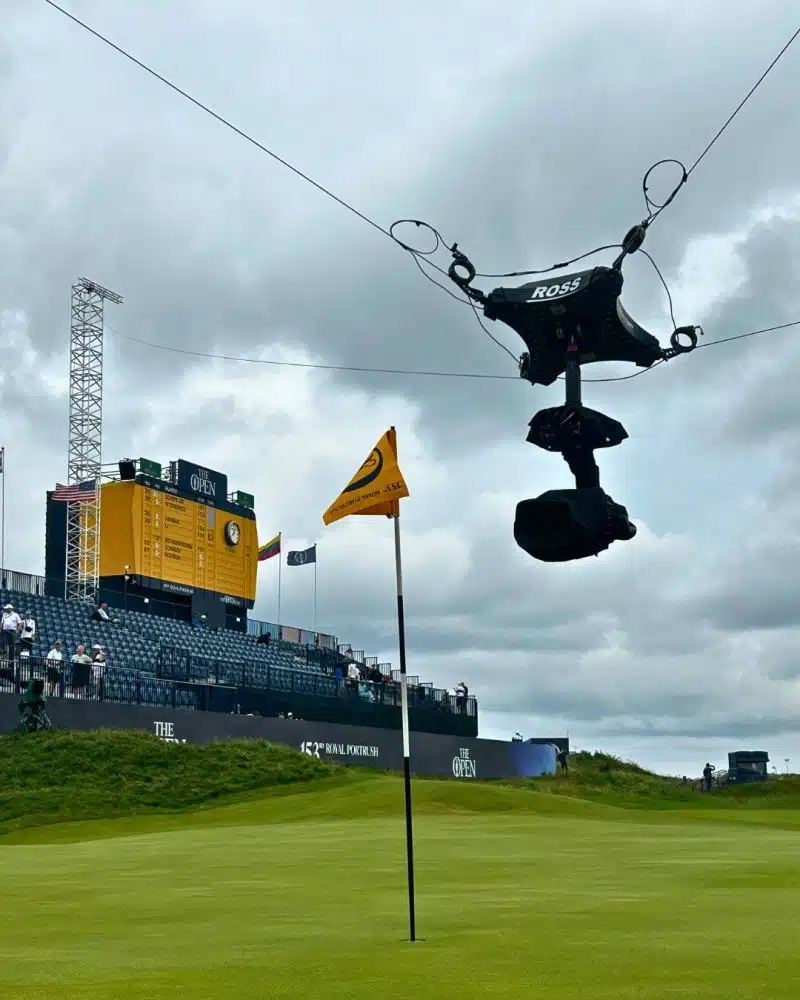By Darren Mullis, Engineering Lead, spidercam
Over the years, I’ve deployed spidercam systems in stadiums and arenas around the world, for every event you can think of — from concerts to cricket to football. But the 153rd Open at Royal Portrush stands out for me. This wasn’t just another project. It was a breakthrough in one of the most tradition-steeped sports.

A first for golf and cable-based cameras
spidercam has a proven track record in football, rugby, cricket, and live entertainment. But golf? That remained a big question mark. Until now.
For the first time in The Open history, a cable-based camera flew over the 18th green, delivering sweeping, cinematic views to millions of fans around the world. From emotional close-ups to smooth tracking across the crowd and course, spidercam brought a new perspective to one golf’s most iconic tournaments.
Redefining golf broadcasts
Before this project, spidercam hadn’t drawn much interest from the golf leagues. So, what changed? Mostly, the appetite of viewers, producers, and broadcasters for more variety and distinction. With so much new content, and particularly new sports content, producers want to stand out any way they can.
Our production partner, EMG, had the vision — and had built the trust — to push those boundaries for The Open. The pitch was the elevated storytelling that spidercam would bring to The Open, with immersive, emotionally resonant, and most importantly, unique camera angles and movements.
A significant challenge in getting a cable-based camera system approved for The Open was that any new technology must be virtually invisible. Golf demands precision, quiet, and respect for the player’s focus. To satisfy those strict conditions, we worked closely with EMG and Unusual Rigging to engineer a setup that was visually unobstrusive but would still give The Open access to all the latest technology available.
The solution was a bespoke four-point support system for spidercam that respected sightlines, avoided distracting players, and preserved the pristine aesthetics of the course.
Planning from afar
Another uniquely challenging aspect of this deployment was that we never set foot on site during planning, due to logistical constraints. Instead, we managed the entire design process remotely, using drone imagery, CAD drawings, and our proprietary spidercam simulation software. That allowed us to virtually map cable paths, flight zones, and potential obstructions precisely without ever physically being there.
Rather than being a compromise, this process demonstrated the robustness of our remote design methodology, showing how complex systems can be engineered and deployed accurately from afar, even under restrictive conditions. Crucially, we were able to incorporate safety checks and redundancy planning at every stage to mitigate risk and ensure reliability on site.
Smooth execution. Zero disruption.
Installation came with its own set of challenges. At Portrush, the coastal winds were a constant factor, particularly during tower setup, when safety margins are at their tightest. Working closely with Unusual Rigging, we installed anemometers linked directly to our operating desk, giving us live wind data to monitor conditions and keep the system safe at all times.
Gameplay added another layer of complexity. To protect players, spectators, and the course (and the cameras!), we pre-defined “no-fly” and “safe park” zones and timings.
Just as important, our spidercam operators worked hand-in-hand with the directors, advising them on what was achievable within the environment and suggesting camera movements that complemented the rhythm of play and would add to the drama and storytelling of the tournament.
The final putt, from a new perspective
The payoff was undeniable: sweeping aerials of chips landing with pinpoint precision, graceful follow-throughs on decisive putts, and that unforgettable closing shot: spidercam gliding silently above the 18th green as the crowd erupted.
Watching that final putt drop with spidercam overhead gave me goosebumps. That moment captured exactly what we set out to achieve. It wasn’t just a technical win. It was a creative leap forward.
spidercam proved it could enhance the emotion of golf for viewers at home without disrupting its natural rhythm, giving directors a new lens for storytelling in golf.
What’s next?
The success at The Open demonstrates what’s possible with spidercam, for golf but in many other sports. The demand for elevated, immersive perspectives continues to grow, especially across extreme sports like skiing and motorsports, where traditional cameras struggle to get close to the action.
Directors and audiences both want more angles that put fans at the center of the moment, and spidercam has built a reputation for delivering them with precision, safety, and reliability in the most demanding environments.
Discover how Robotics is changing the game in Sports Broadcasting & download our free Robotics Guide.

Technology snapshot
- System: spidercam ELITE with newly engineered X Dolly
- Remote Head: Newton S2
- Camera: Sony P43 UHD
- Software: Proprietary Spidercam Simulator for planning and navigation
- Crew: 3-person rotating team – pilot, operator, and technician